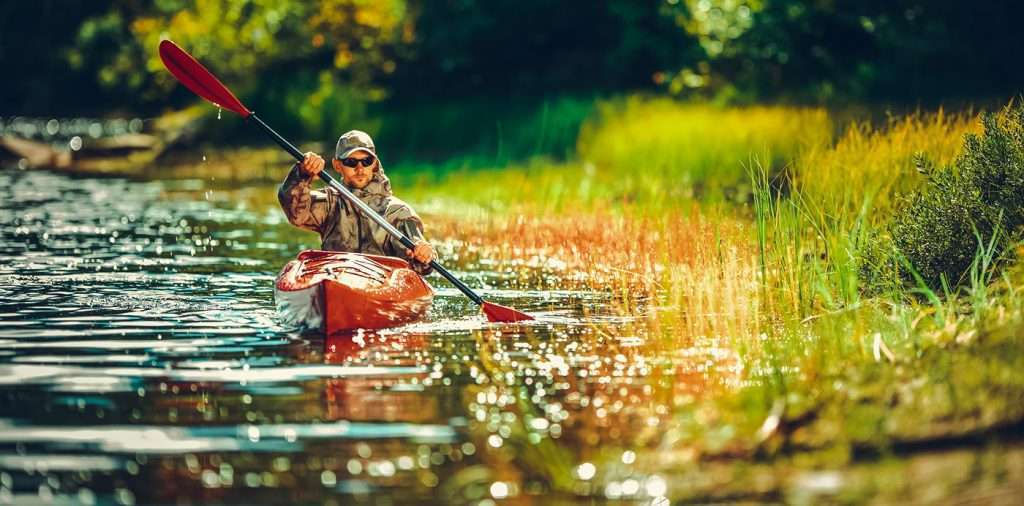You might be wondering why anyone would even want to kayak at night. After all, the dark night skies only make the sport more difficult and dangerous. Well, some people prefer to kayak at night to avoid the sweltering mid-day temperatures. Other people prefer to kayak at a night for a chance to do some fishing. If you’re planning a nighttime kayaking trip, however, there are a few things you should know. Here, we’re going to reveal some tips on how to safely kayak at night.
1. Make Yourself Visible
The single most important piece of advice for anyone attempting to kayak at night is to make yourself visible. If you remain completely dark on the water, a larger boat or vessel could unknowingly collide into your kayak. Although the chance of this happening is rare, it’s something you shouldn’t risk. A simple 360-degree light could end up saving your life on the off chance that a large boat comes sailing your way.
Of course, another reason why you should make yourself visible on the water is that the U.S. Coast Guard requires it. “A vessel under oars may display those lights prescribed for sailing vessels or have ready at hand an electric torch or lighted lantern showing a white light which shall be exhibited in sufficient time to prevent a collision.” So, keep that in mind when you are kayaking during the dark of night.
2. Which Light Should I Choose?
There are dozens of different lights and lamps made specifically for small watercraft. I recommend choosing at least two high-powered LED lamps with strong battery life. You can place one on each end of the kayak for optimal visibility. Even though the U.S. Coast Guard requires just one, using two will serve as an additional level of protection. Besides, it’s nice to know that you have a backup light ready just in case the first one dies.
3. Headlamp
Another important tool that I highly recommend for nighttime kayaking is a headlamp. When you’re hands are busy rowing or messing with fishing tackle, you’ll still be able to easily see the area in front of you thanks to a headlamp. With that said, you need to choose a waterproof headlamp to prevent damage from the water. Trust me, there’s nothing worse than buying a brand new headlamp only to have it ruined from your first nighttime kayaking excursion.
4. Expect The Unexpected
There are still a few things you should be aware of when nighttime kayaking, even with all these safety tips in mind. For example, never forget that during a full moon cycle it’s harder to see at night since there will be additional light from the moon shining down on the water. Also, always listen for large boats and other marine vessels as they may not have enough time to see you before passing by. This means that you need to remain extra cautious while out on the water at night because anything can happen at any given moment. With that said, what else do you think is important information about how to safely kayak at night?
5. Check weather and tides
Before setting out on a kayaking trip at night, you should always check the weather and tides. While the moonlight may provide enough lighting to find your way, it’s important to be aware of any dangerous conditions that may arise during your trip (e.g., low tide when entering from a river). Being prepared for anything could mean the difference between having a good time or being in danger.
6. Don’t use new kit
If you don’t usually kayak at night, you should avoid using new gear on this kayaking trip. For example, if it’s your first time using a headlamp (and the beam isn’t focused), then it will take some getting used to. If anything were to go wrong with your equipment that was brand new, you wouldn’t be able to blame yourself for not knowing how to properly use it.
7. Training required
Finally, before planning an overnight kayaking trip during the nighttime hours, make sure that everyone in your group has proper training and experience operating their watercraft. This is especially important for someone who may have never been fishing before or even held a fishing pole before. If you plan to go kayaking at night, make sure everyone is well aware of what they are doing and how to do it in case something unexpected happens. It’s not worth jeopardizing your safety just because one person may not know what they are doing.
Conclusion
Kayaking during the nighttime hours can be exciting, but it’s important that everyone understand their limits before attempting this type of activity. This means that if you aren’t experienced with kayaking or even fishing before, then you should only attempt a short trip out on the water for the first time until you feel comfortable paddling around while it gets darker outside. With these tips in mind, hopefully every kayak outing will be safe and enjoyable.

